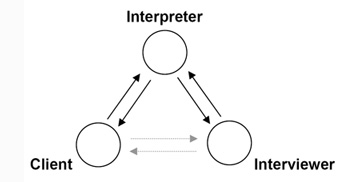Interpreting process
This page has information to help you decide when to use an interpreter and what is included in the interpreting process.
When to use an interpreter
You should use an interpreter when a person meets any of the following:
- shows no understanding of English
- is able to communicate in English but in a limited capacity
- is able to communicate in English but is more comfortable in their own language
- is under stress which may affect their ability to communicate in English.
You should also use an interpreter if you can't understand the person who is talking.
Using an on-site interpreter
The following information is a guide to the process of using an on-site interpreter.
Before the interview
It is important that you have a short briefing with the interpreter to inform them of the purpose of the interview.
You must tell them if you will be using ‘jargon’ or technical terms, and you may need to explain in English what these terms mean.
Many English terms and concepts do not have an international language equivalent.
The briefing gives the interpreter the chance to ask questions about the subject matter of the session and about difficult terms in order to understand and interpret them properly.
The briefing also helps to decide what style of interpreting is required.
At the start of the interview
At the beginning of the interview you should introduce the interpreter and allow the interpreter to explain their role.
Many people have never been provided with an interpreter and need to understand that the interpreter is there only to interpret what you are saying, not to take sides, give advice or make judgements.
You should also reassure the client that the interpreter is under a strict code of ethics and can not tell anyone outside the meeting what was said.
Always remember, you are in charge of the interview, not the interpreter.
Seating arrangements
Seating arrangements are important as they can help the interpreting process.
Below is the ideal triangular seating arrangement. Generally, this arrangement will help your client feel comfortable and not intimidated.

During the interview
During the interview you should do all of the following:
- speak clearly using short sentences and plain English
- only speak one idea at a time
- pause to allow sufficient time for the client to answer and the interpreter to interpret
- permit the interpreter to ask for clarification or repetition if the message from either party is unclear
- speak directly to the client, not the interpreter, so they can see your facial expression, and you can see theirs - but be aware that direct eye contact is inappropriate or considered to be bad manners in some cultures
- avoid chatting with the interpreter and also discourage the client from chatting to the interpreter
- stay in the interview room - leaving the room can make it awkward for the interpreter and client, and can place the interpreter in a compromising position
- never ask the interpreter for his/her personal opinion of the client or their actions
- clarify if the message has been understood both ways, ask the client to tell you what they think you have said in their own words.
After the interview
When the client has left, debrief the interpreter, especially after stressful and traumatic sessions.
Using a telephone interpreter
The following information is a guide to using the national telephone interpreter service.
At the start of the interview
You will first call 131 450. This is a national number and is not managed by Interpreting and Translating Service NT.
You will need to provide your name and telephone number.
Depending on how long the wait will be to connect to an interpreter, you may be asked to wait on line or they may call you back.
If you deal regularly with non-English speakers, you should get a dual handset or a loud speaking facility telephone to enable efficient communication between all parties concerned.
Once everyone is connected, you should do all of the following:
- take charge of the interview
- introduce yourself and the interpreter to the client
- let the interpreter know what type of equipment you are using - for example, speaker phone, a conference call facility or whether you and the client are on separate phones.
During the interview
During the interview you should do all of the following;
- give a short brief of what you are going to discuss and explain the role of the interpreter
- give clear instructions to the interpreter about any special requirements
- speak directly to the client using the first person
- use clear language
- use short simple sentences
- pause after two or three sentences to allow the interpreter to speak
- make allowances for the interpreter on the telephone because he or she has no visual cues to help in the interpreting
- clearly indicate the end of the session to the interpreter.
Give feedback about this page.
Share this page:
URL copied!